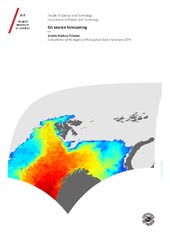| dc.contributor.advisor | Graversen, Rune | |
| dc.contributor.author | Fritzner, Sindre Markus | |
| dc.date.accessioned | 2020-04-28T08:31:54Z | |
| dc.date.available | 2020-04-28T08:31:54Z | |
| dc.date.issued | 2020-05-15 | |
| dc.description.abstract | Accurate sea-ice prediction is essential for safe operations in the Arctic and potentially also for weather forecast at high-latitudes. The increasing number of sea-ice related satellite observations in the Arctic can be used to improve the model predictions through data assimilation. For sea ice, sea-ice concentration (SIC) observations have been available for many years. Observational information of SIC can be used to constrain the sea-ice extent in models. In addition to SIC, other sea-ice related observations such as sea-ice thickness (SIT) and snow depth have recently become available. The assimilation of these observations is expected to have a substantial impact on the sea-ice forecast.
In this thesis, the main goal is to enhance the sea-ice model forecast accuracy by improving the initial model state on which the forecast is based. Primarily, the assimilation of sea-ice-related observations that are previously little used in sea-ice data assimilation is investigated. This includes the assimilation of SIT, snow depth and high-resolution SIC observations. A secondary objective of this thesis is to reduce the computational cost of both sea-ice assimilation and modelling. A new direct and computationally cheap method for data assimilation, the Multi-variate nudging (MVN) method, is proposed as an alternative to more complex assimilation methods for sea-ice. In addition, to reduce the computational cost of the sea-ice prediction, two machine-learning methods were applied for sea-ice forecasting, a fully convolutional network and a k nearest neighbours.
It is found that the assimilation of observations other than SIC has the potential to enhance the accuracy of sea-ice models and improve predictions. The proposed new assimilation method, the MVN, proves to be a valid assimilation alternative to the Ensemble Kalman Filter when few observation types are available, and the computational resources are limited. The machine-learning forecasts are found to improve upon persistence and show comparable skills to the dynamical model. Hence there is a potential for machine-learning methods for sea-ice predictions which should be developed further. | en_US |
| dc.description.doctoraltype | ph.d. | en_US |
| dc.description.popularabstract | Recent global climate change has led to an increased focus on Arctic sea ice. For the prediction of future climate scenarios, accurate prediction models are important. In addition, accurate sea-ice predictions are important for safe operations in the Arctic and potentially also for weather forecast at high latitudes. In this thesis, we aim to improve numerical sea-ice predictions by utilising satellite observations. With satellites, a vast number of Arctic sea-ice observations are produced every day, and these observations can be combined with numerical models for improved prediction. By utilising observations of sea-ice extent, sea-ice thickness and snow thickness, we improve the sea-ice prediction accuracy. In addition, as an alternative to traditional physical-based prediction models, we investigate the use of statistical prediction models based on machine learning. With these models, a similar prediction accuracy as the dynamical model is found, proving that this can potentially be a simple prediction alternative. | en_US |
| dc.description.sponsorship | Norwegian Research Council grant no. 237906, Norwegian Metacenter for Computational Science (NOTUR) project NN9348K | en_US |
| dc.identifier.isbn | 978-82-8236-395-2 | |
| dc.identifier.uri | https://hdl.handle.net/10037/18141 | |
| dc.language.iso | eng | en_US |
| dc.publisher | UiT Norges arktiske universitet | en_US |
| dc.publisher | UiT The Arctic University of Norway | en_US |
| dc.relation.haspart | <p>Paper I: Fritzner, S.M., Graversen, R.G., Wang, K. & Christensen, K.H. (2018). Comparison between a multi-variate nudging method and the ensemble Kalman filter for sea-ice data assimilation. <i>Journal of Glaciology, 64</i>(245), 387–396. Also available in Munin at <a href=https://hdl.handle.net/10037/13969>https://hdl.handle.net/10037/13969</a>.
<p>Paper II: Fritzner, S., Graversen, R., Christensen, K.H., Rostosky, P. & Wang, K. (2019). Impact of assimilating sea ice concentration, sea ice thickness and snow depth in a coupled ocean–sea ice modelling system. <i>The Cryosphere, 13</i>, 491–509. Also available in Munin at <a href=https://hdl.handle.net/10037/16412>https://hdl.handle.net/10037/16412</a>.
<p> Paper III: Fritzner, S., Graversen, R. & Christensen, K.H. Assessment of high-resolution dynamical and machine learning models for prediction of sea-ice concentration in a regional application. (Submitted manuscript). | en_US |
| dc.relation.isbasedon | Fritzner, S. (2019). Assessment of high-resolution dynamical and statistical models for prediction of sea-ice concentration [Data set]. Norstore. <a href=https://doi.org/10.11582/2019.00038>https://doi.org/10.11582/2019.00038</a>. | en_US |
| dc.relation.isbasedon | Fritzner, S. (2019). Model output, Article: Impact of assimilating sea ice concentration, sea ice thickness and snow depth in a coupled ocean-sea ice modeling system [Data set]. Norstore. <a href=https://doi.org/10.11582/2019.00005>https://doi.org/10.11582/2019.00005</a>. | en_US |
| dc.rights.accessRights | openAccess | en_US |
| dc.rights.holder | Copyright 2020 The Author(s) | |
| dc.rights.uri | https://creativecommons.org/licenses/by-nc-sa/4.0 | en_US |
| dc.rights | Attribution-NonCommercial-ShareAlike 4.0 International (CC BY-NC-SA 4.0) | en_US |
| dc.subject | Sjøis | en_US |
| dc.subject | Data assimilasjon | en_US |
| dc.title | On sea-ice forecasting | en_US |
| dc.type | Doctoral thesis | en_US |
| dc.type | Doktorgradsavhandling | en_US |


 English
English norsk
norsk
